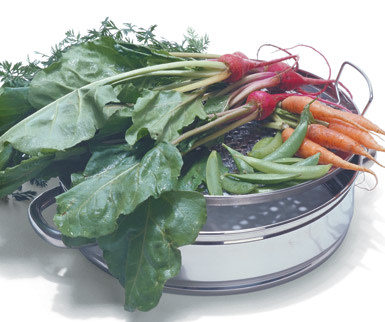Handy Tips For Steaming Vegetables

Handy Tips for Steaming Vegetables No doubt about it—tender, sweet baby vegetables are a sure springtime treat. And steaming is ideal for keeping them at the top of their game.
Boiling leaches nutrients and flavor out of vegetables and into the cooking water. Sautéing in butter or oil can overpower delicate flavors. But steamed vegetables taste like themselves—with vitamins and flavor intact and no added fat.
Liquid plus heat equals steam: It's that easy. The following tricks will give you the best results.
First, use a perforated container and a pan with a tight lid. Some pans have inserts made to fit, which is the ideal option, but they can be pricey. Collapsible steaming baskets are fine too. In a pinch, a footed colander inside a pot works, too—just be sure the lid fits tightly.
A tight lid is essential because it traps steam inside the pan, creating an extremely hot, sauna-like environment, which is the reason steaming cooks foods so quickly. Take care when lifting the lid—steam can burn as badly as oil.
The vegetables should fit in the steamer in one layer, another reason a steam insert is preferred. This allows steam to circulate around the vegetables and ensures even cooking. Just be sure the vegetables remain above the water, not touching it.
Steaming At A Glance These are the proper steaming times for popular spring vegetables.
Asparagus 3–5 minutes
Baby beets 12–15 minutes
Broccoli 4–5 minutes
Baby carrots 3–4 minutes
Cauliflower 4–5 minutes
Green beans 4–5 minutes
Parsnips 4–6 minutes
Pea pods 1–2 minutes
New potatoes 10–12 minutes
Product Recommendations
Interested in cooking? Need some supplies?
Check out some of the tools we like. All products featured on Cuisine at Home are independently selected by our editors; we may earn an affiliate commission from qualifying purchases through our links.